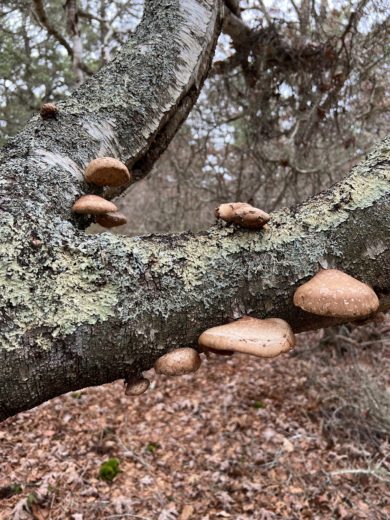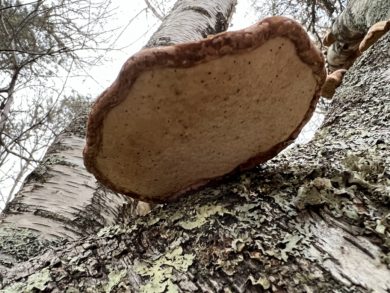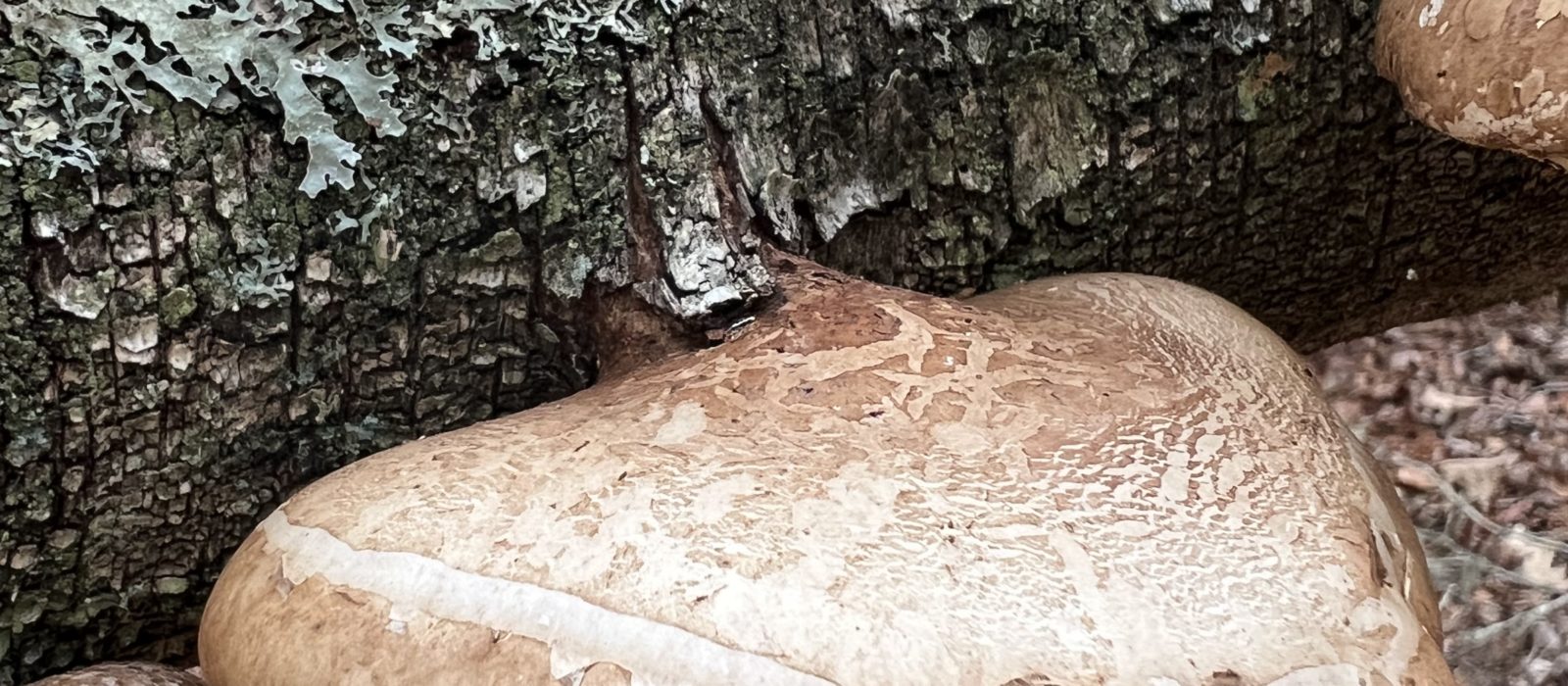Versatile Fungus Found in Edgartown
What’s the connection between Ötzi the Iceman and Martha’s Vineyard? The surprising answer is the fungus Fomitopsis Betulina, also known as birch polypore, birch bracket, and razor strop fungus.
Greg Palermo and I were out looking for mosses in a wooded area near Edgartown Great Pond recently, and a large, multi-trunked, native Betula populifolia (gray birch) caught our eyes. The tree itself was lovely, but what really drew our attention were the hoof-shaped, light grayish brown fruiting bodies of birch polypore, Fomitopsis betulina, covering one of the arching trunks. I recognized the fungus as birch polypore but didn’t know about the myriad uses of this fungus until I got home and did some research. I was also surprised to find no previous observations of this fungus on the Vineyard in iNaturalist, so I was able to add another species to the Martha’s Vineyard Atlas of Life project in iNaturalist.
Fomitopsis betulina is one of the most common species of brown rot fungus (meaning that it consumes cellulose, versus white rot fungus, which consumes lignin) found around the world, mainly in the Northern Hemisphere. It grows exclusively on birch trees, causing brown rot and eventually death of the tree. The spores evidently enter through wounds or weakness in the bark and begin parasitizing the cellulose in the tree. Although Fomitopsis betulina is an annual, its fruiting bodies will persist on wood through the winter and into the next season.

Birch polypore has been widely used for at least 5,300 years in traditional medicines, and has been extensively studied for its phytochemistry and pharmacological activity. Phytochemicals found in the fungus include phenolic acids, indole compounds, sterols and triterpenes. These compounds and others have antiviral, antibiotic, anti-inflammatory, anti-tumor, antiseptic, and even antifungal (yes, inhibiting the growth of other fungi) properties. The flesh of the fruiting body of the fungus also stanches bleeding. Furthermore, agaric acid found in the fruiting bodies is poisonous to the parasitic human whipworm Trichuris trichiura…and this brings us to Ötzi the Iceman, the famous 5,300-year-old mummified man found in the Tyrol region of the Italian Alps in 1991.
According to various web sources, among the items found on Ötzi was a leather thong around his neck onto which were threaded some dried pieces of Fomitopsis betulina (and another fungus as well). Whipworm eggs were found in Ötzi’s intestinal tract. Birch polypore, in addition to being poisonous to human whipworm, acts as a laxative. Perhaps Ötzi was self-medicating for relief? Seems likely. (Another interesting factoid about Ötzi is that he, like many Vineyarders, had Lyme disease, making him the oldest known human case.)

The WildFoodUK webpage for Fomitopsis betulina nicely sums up some of the other traditional uses of this fungus:
“A plaster can be made from the underside of the mushroom. A strip needs to be cut and carefully removed from the pore membrane. This provides a microporous, antifungal, antiseptic and self-sticking plaster, much better than can be purchased from the shops….A corn or blister plaster can be easily fashioned from the flesh of the mushroom by cutting some flesh into a doughnut shape of the right size and applying to the corn or blister….The common name Razor Strop Fungus comes from the use in old barber shops of cutting a strip from the underside of the fungus, drying it and sticking it to a piece of flat wood. This was used to give the final finish to the cut-throat razors that barbers used. I’m not sure if they were aware of the fact, but in doing so they were giving their blades an antiseptic, antifungal and styptic wipe! The fungus has also been used in the past as very fine emery cloth to polish metals, making ink blotters, and even bases for mounting insects for collections. Truly the Swiss Army knife of mushrooms.”
But this isn’t the end of the uses of this multi-tool fungus. It can also function as tinder, holding and maintaining an ember for quite some time and thus saving the user the time and effort of having to start a fire from scratch. Humans aren’t the only ones who value this fungus. The fruiting bodies harbor a large number of species of insects that depend on it for food and shelter. One large study found 257 arthropods, including 172 insects and 59 mites, in the samples collected.
We don’t really know if Fomitopsis betulina is truly rare on Martha’s Vineyard, or just under-reported. You can help clarify the local status of this useful fungus by looking for it on any birch trees you find and posting photographs in iNaturalist if you encounter it.
Margaret Curtin is a research associate of the Polly Hill Arboretum. She and her partner, Greg Palermo, are working to document all the species of vascular plants and bryophytes that grow wild on MV. Margaret also serves on the BiodiversityWorks Board of Directors.
